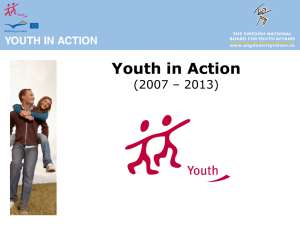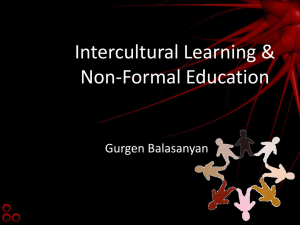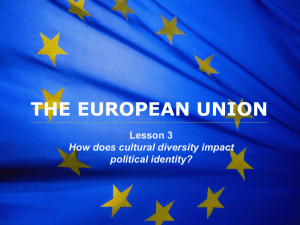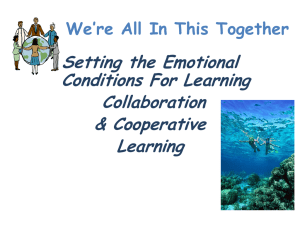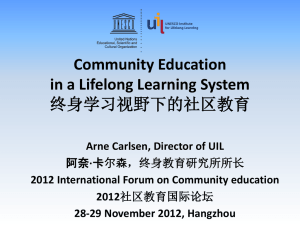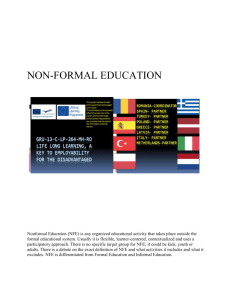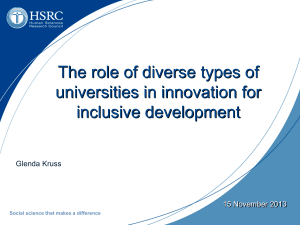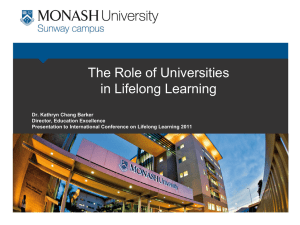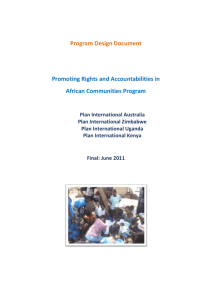Paul Downes` presentation - `Access to Education in - Eucis-LLL
advertisement
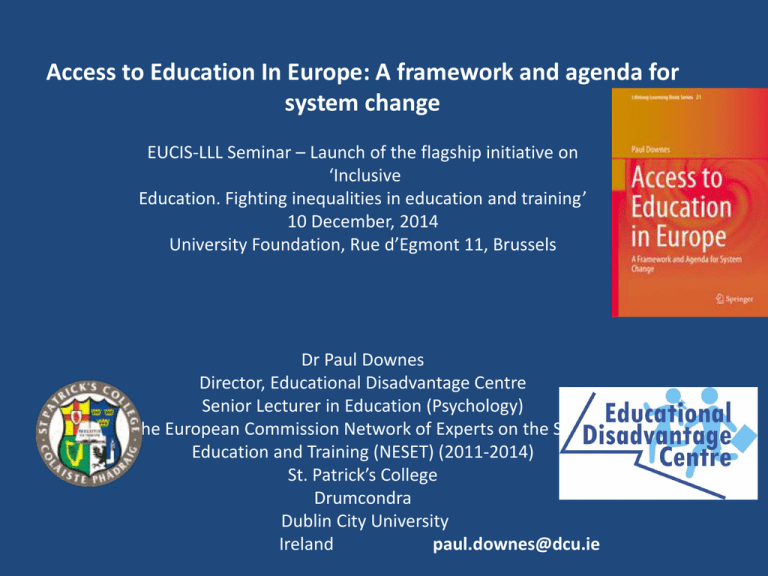
Access to Education In Europe: A framework and agenda for system change EUCIS-LLL Seminar – Launch of the flagship initiative on ‘Inclusive Education. Fighting inequalities in education and training’ 10 December, 2014 University Foundation, Rue d’Egmont 11, Brussels Dr Paul Downes Director, Educational Disadvantage Centre Senior Lecturer in Education (Psychology) Member of the European Commission Network of Experts on the Social Aspects of Education and Training (NESET) (2011-2014) St. Patrick’s College Drumcondra Dublin City University Ireland paul.downes@dcu.ie EU2020 Headline Targets for Education – Access to higher education for socio-economically marginalised groups falling between two stools (1) The share of early leavers from education and training should be less than 10 %. (2) The share of 30–34-year-olds with tertiary educational attainment should be at least 40 % [This implies a focus on access to higher education for socio-economically marginalised groups – this focus has not been sufficiently developed] Launched in February 2013, the Commission’s UMultirank proposes to rate universities in five separate areas—reputation for research, quality of teaching and learning, international orientation, success in knowledge transfer and start-up contribution to regional growth. A glaring omission here is a focus on access for diversity and community engagement. This is indicative of the lower level of priority currently given at European Commission level to access to education issues for marginalised groups. WHAT HAPPENED TO THIS??? EU Council ( 2009 /C 119/02) agrees on a range of strategic priorities for lifelong learning that go far beyond simply employment goals to include social cohesion, personal and social fulfilment and active citizenship: “1. In the period up to 2020, the primary goal of European cooperation should be to support the further development of education and training systems in the Member States which are aimed at ensuring: (a) The personal, social and professional fulfilment of all citizens (b) Sustainable economic prosperity and employability, whilst promoting democratic values, social cohesion, active citizenship, and intercultural dialogue” Across the 12 national reports, 196 interviews took place in total with members of senior management from 83 education institutions, as well as from senior officials in government departments relevant to lifelong learning in each country. Sixtynine of these interviews were with senior representatives from higher education across 30 institutions. Austria, Belgium, Bulgaria, England, Estonia, Hungary, Ireland, Lithuania, Norway, Russia, Scotland and Slovenia. A Framework Focusing on System Blockage A major limitation to Bronfenbrenner’s ( 1979 ) framework of concentric nested systems of interrelation is that it tended to omit a dynamic focus not only on time but on system change . This gap in understanding system change means that Bronfenbrenner’s influential accounts offer little understanding of system blockage and displacement. A Systemic Approach to Evaluation and Transparency: Structural Indicators STRUCTURAL INDICATORS OF A SYSTEM FOR TRANSPARENCY: YES/NO ANSWERS BY ANALOGY WITH UN RIGHT TO HEALTH (DOWNES 2014) • Structural indicators (SIs): Generally framed as potentially verifiable yes/no answers, they address whether or not key structures, mechanisms or principles are in place in a system. As relatively enduring features or key conditions of a system, they are, however, potentially malleable. They offer a scrutiny of State or institutional effort (Downes 2014, see also UN Rapporteur 2005, 2006) Structural Indicator (SI) A Central Driving Committee at State Level for Access to Higher Education and Lifelong Learning for Marginalised Groups, Including Clear Funding Sources In the Austrian national report that there is a central committee at national level for lifelong learning but not for access and social inclusion issues in education An Estonian official interviewee uses finance as a rationale to advocate a laissez-faire approach in this area of access, socioeconomic disadvantage and lifelong learning: If we wished to create such structural units we should change the present division of work. Greater centralisation means more officials. We cannot afford that at the moment so the answer is no—the creation of such structural units is not on the agenda right now. Educational institutions, in particular institutions of higher education should be able to solve these problems themselves—this is what autonomy means. Speaking about long term development—maybe one day there will be some structural changes as well (Tamm and Saar 2010 ). SI - Clarification of the Criteria to Ascertain Socio-economic Exclusion in Hungary, the interviewed Education and Culture Ministry official recognises that there is not a transparent set of criteria for establishing socioeconomic exclusion but rather this identification is somewhat ‘vague’ apart from identification by ethnicity: The underprivileged situation is a rather vague concept because underprivileged statuses can change in different periods. Currently such people are the ones who need special education, the underprivileged ones, the young Roma, the persons without any qualification, so the ones who fell from the educational system (Balogh et al. 2010 ). It appears that the problem is not so much from a lack of legal definition for socio-economic exclusion in Hungary, but rather its application in practice beyond ethnicity criteria, in an often rapidly changing environment A focus on socio-economic exclusion based solely on low income as distinct from low income plus education level, education level of parents, accommodation type and possibly area of residence would make this target group one that is less dynamically changing. A common feature of interviews across institutions and national policy officials in Estonia, Bulgaria, Russia and Slovenia is that there exists neither criteria for access to higher education based on poverty, low parental education or socio-economic background nor a particular awareness of or willingness to seek such criteria. In Hungary and Lithuania, there is some focus on low income though this criterion appears relatively underdeveloped conceptually and also with regard to data collection for such a target group for access. SI- Education Institutional Strategies for Access for Groups Experiencing Socio- economic Exclusion Slovenian University official: There is also no formal committee to promote and implement an agenda for increased access in the college and they are also not systematically monitoring the number of marginalised students. We would tackle this if the number or pressure were, let’s say, bigger (Ivančič et al. 2010 ). SI- University Outreach Strategy to Communicate with Spokespersons, Opinion Makers and Community Leaders in Socioeconomically Marginalised or Ethnic Minority Communities The Norwegian national report observes from one educational institution that: The communities are approached by building on existing networks and associations as well as making use of spokespersons and opinion makers within the communities. Students with a corresponding ethnic background are engaged as role models, communicating in their familiar language at meetings with the target groups (Stensen and Ure 2010 ). SI- Formal Links Between Universities and Non- governmental Organisations Representing Marginalised Groups The Bulgarian national report observes that ‘no interaction is evident between the NGO sector and the formal education system’ (Boyadjieva et al. 2010 ). However, a Bulgarian institutional interviewee recognises the need for such interaction: There should be more aggressive policy, targeted towards these groups i.e. they should organise on purpose. To help disadvantaged people to overcome the barrier of integrating with the other students, this is the greatest responsibility of the NGOs. In other words, to reduce the stress these people experience being disadvantaged. The organisation of courses can help overcome this psychological problem. Why not have courses for plumbers for the minority groups? (Boyadjieva et al. 2010 ). SI- Outreach Strategy to Engage Young Immigrants and Young Members of a Target Group: Cohort Effect as a Positive Potential Norwegian national report: Immigrants’ perception of higher education should be changed. Hence, the solution has been to target specific nationalities, namely young immigrants, their parents and even the community they form part of. The latter point is illustrated by differences between immigrant communities in their propensity to start up higher education studies. In this regard, our informant reports that ethnic communities that are unified, such as Indians, Tamils and Vietnamese, more easily develop a culture emphasising the value of educational skills, while such attitudes are less easily nurtured in, e.g., the more fragmented Somalian community (Stensen and Ure 2010 ). SI- An Access Strategy of Third-Level Institutions Which Engages with Primary and Secondary Students Experiencing Socio-economic Marginalisation The Scottish national report provides one of the rare examples of a strategic approach to access to education which engages with younger learners, including those at the primary school level: The college was heavily engaged with local schools with many children from 3rd and 4th. Members of staff had a big involvement with schools: We teach in schools, we run special projects for primary school kids so the kids in school are aware of us from a young age, they are aware of the college and what it does and when it comes time for them to leave school, college is seen as an opportunity for them (Executive Director, College A) (Weedon et al. 2010 ). SI- The Need for a National and Regional Strategy for Non-formal Education: To Relate But Not Reduce Non- formal Education to the Formal System This response from the Austrian Education Ministry official illustrates the low priority given to non-formal education in Austria: Which government department has the main responsibility for funding non-formal educational organisations? Responsibility, probably nobody (laughing), and everybody is doing a little…From a political point of view it is the Ministries of Education, Economics and Social Affairs. I would say that the real existing responsibility lies within this triangle. But nonformal education is something that’s being treated with a little negligence, we know that when we look at Scandinavia or the Anglo-Saxon area… (Rammel & Gottwald 2010). Bulgarian national report: According to the respondent, there is no strategy for development of the non-formal sector at national or regional level. (Boyadjieva et al. 2010 ) The Lithuanian national report highlights the need for fresh strategic direction at national level in relation to non-formal education: Lithuania has Education Strategy, but non-formal education is not emphasised. Only the references to the existing Law on Non-Formal Education are given. In expert opinion the latter is: […] is quite outdated, it was adopted in 1998. […] (Taljunaite et al. 2010 ). SI- Funded Strategies to Develop Local Community Lifelong Learning Centres Community-based lifelong learning centres bring education into the centre of a local area, as is highlighted in the Scottish national report: The location of classes were ‘where they are needed’ , a range of different premises were used and crèches were sometimes provided though the interviewees also noted that there was more nursery provision now through the education system. We run these where it meets the needs of local people. So it could be in a church hall. It could be in a community centre. Anywhere that suits the needs (Weedon et al. 2010 ). SI Funded Strategies to Develop Local Community Lifelong Learning Centres Less in evidence from the national reports, with the exception of Ireland, are examples of community-based lifelong learning centres which engage with the vision of lifelong learning as being from the cradle to the grave, as is the EU Commission definition. In other words, a missed opportunity currently exists to engage with whole communities of non-traditional learners from an early age and as parents. SI Staff Continuity and Development in Non-formal Education The Norwegian national report emphasises the following context of particular need for continuity in non-formal education: importance for staff continuity is especially strong for immigrants and language learning: When the teacher is sick, they have to cope with new teachers. Within a short time span they may have three substitute teachers. I recognise the participants place from when I attended the Norwegian courses, I got used to how the teacher spoke, but suddenly there is a new teacher with a new dialect and then it all stops. And after two days an additional substitute teacher arrives and he does not know the progression we have been following. In the end it all becomes very frustrating (Stensen and Ure 2010). EUCIS campaign to promote an access to higher education for socio-economically excluded groups to develop a review process driven by the Commission and Parliament, based on implementing the EU2020 headline target ?? Features of Review Process a) Establish a working group in DG EAC of senior civil servants across EU member states plus civil society representatives on access to higher education for socio-economically excluded groups b) Seek country-specific reports that respond to proposed agenda of structural indicators for access to higher education for socio-economically marginalised groups. Features of EU2020 Headline Target Review Process c) As part of this country-specific level review process reporting to the Commission DG EAC in light of the EU2020 headline target on third level education, third level institutions would be invited/required to respond to the proposed institutional structural indicators for access to higher education for socioeconomically marginalised groups EUCIS campaign to promote a country-specific nonformal education review process driven by the Commission and Parliament, based on implementing the 2009 Council Resolution with a focus on responses to the proposed nonformal education structural indicators ?? REFERENCES Balogh , A., Józan, A., Szöllősi, A & Róbert, P. (2010). The institutional aspects of adult education in Hungary. TARKI Social Research Centre Boyadjieva, P., Milenkova, V., Gornev, G., Petkova, K. & Nenkova, D. (2010). The role of Bulgarian educational institutions for the promotion of access of adults to formal education Bronfenbrenner, U (1979) The Ecology of Human Development. Cambridge MA : Harvard University Press Downes, P (2014) Access to Education In Europe: A framework and agenda for system change. London: Springer EU Council (2009/C 119/02) Council conclusions of 12 May 2009 on a strategic framework for European cooperation in education and training (‘ET 2020’) Ivančič, A., Mohorčič Špolar, V.A. & Radovan, M. (2010). The case of Slovenia. Access of adults to formal and non-formal education – policies and priorities Rammel, S., & Gottwald, R. (2010). Social inclusion in formal and non formal adult education: Findings from Austrian institutions and government representatives. Stenson, O-A., Ure, O-B. (2010). The access of adults to formal and non-formal education in Norway. Taljunaite, M., Labanauskas, L., Terepaite-Butviliene, J . & Blazeviviene, L. (2010). The access of adults to formal and non-formal adult education Tamm, A & Saar, E. (2010). LLL2010 Subproject 5 ESTONIA Country Report UNITED NATIONS Economic and Social Council 3 March 2006. COMMISSION ON HUMAN RIGHTS ECONOMIC, SOCIAL AND CULTURAL RIGHTS. Report of the Special Rapporteur on the right of everyone to the enjoyment of the highest attainable standard of physical and mental health, Paul Hunt Weedon, E., Riddell, S., Purves, R & Ahlgren, L. (2010). Social Inclusion and Adult Participation in Lifelong Learning: officials’, managers’ and teachers’ perspectives
